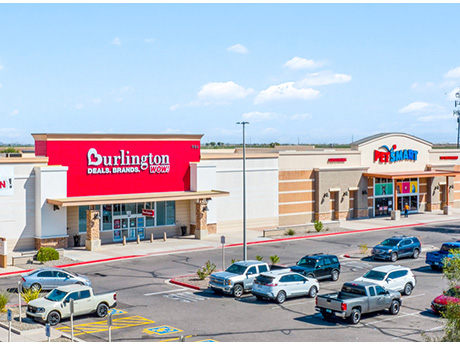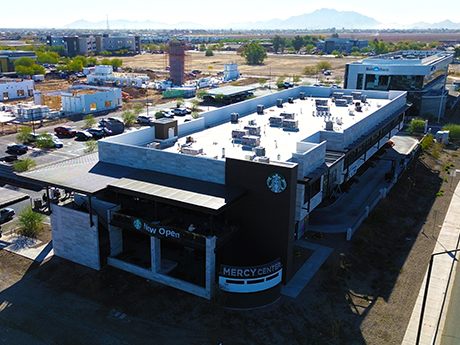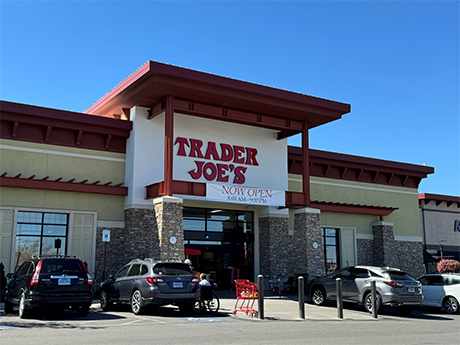— By John K. Jackson of Colliers Phoenix — Casa Grande, Ariz., stands at a pivotal juncture that could see it transition into a Tier II retail market this year. Phoenix’s Greater Metropolitan Area has been characterized by historically low retail vacancy rates, prompting retailers and developers to explore opportunities outside the urban core. Casa Grande’s strategic location less than 50 miles south of Phoenix Sky Harbor International Airport makes it well-positioned to capitalize on this migration. The Dynamics of Casa Grande’s Growth Casa Grande has experienced notable growth in recent years. It was the seventh fastest-growing U.S. city in 2021, experiencing a remarkable 24 percent population increase since 2016. This growth, paired with job creation across sectors, is attracting major employers, including Lucid, LG Energy Solution and Kohler. These three firms promise to collectively bring more than 6,400 jobs to the area. Such economic development lays a solid foundation for retail expansion. After all, a growing workforce typically leads to increased consumer demand. The significant investments being made in the area further bolster Casa Grande’s potential as a retail hub. Lucid has recently expanded its manufacturing complex to 4 million square feet, with plans for additional land acquisition to support …
Western Market Reports
— Scott Hintze and Marti Weinstein of Diversified Partners Commercial Real Estate — Phoenix’s retail development market is seeing a surge in optimism as the city benefits from a growing economy and a shift in political leadership. With the new administration coming into power, the outlook for the Phoenix retail market has become increasingly positive, promising a wave of new projects and investment opportunities in the coming years. The city’s rapid population growth, expanding infrastructure and bustling job market have positioned Phoenix as one of the most attractive cities in the U.S. for retail development. The new administration has brought a renewed focus on urban development, job creation and business-friendly policies, which is expected to help stimulate both demand for retail spaces and the construction of new commercial properties. Government support, including incentives for developers and tax breaks for businesses, is anticipated to foster a thriving retail sector that will benefit both local residents and national retailers looking to expand into the area. Several projects we have been working on have seen unprecedented demand from tenants. We recently completed a 25,000-square-foot building across from Gilbert Mercy Hospital that includes a two-story Starbucks, the first in the market. In addition to …
— By Brett Polachek of Newmark — Phoenix’s multifamily market experienced dynamic shifts in 2024, driven by strong population growth, economic expansion and single-family cost of ownership. Phoenix remains a top relocation destination, with a population growth rate of 1.8 percent (+85,000 residents), nearly double the national average of 0.98 percent. This influx is supported by the addition of more than 52,000 jobs from October 2023 to October 2024. Phoenix also has the fifth healthiest rent-to-income ratio among 30 major U.S. markets that we sampled. Demand for multifamily housing reached record levels, with 14,528 units absorbed annually, marking the strongest performance since 1994. The supply experienced an annual increase of 6.4 percent as 19,835 units delivered last year. The far West Valley submarkets of Avondale, Goodyear and West Glendale led supply growth, adding 6,100 units to their inventory. The market showed resilience despite this historic supply wave. Occupancy rose 1 percent year over year to 93.7 percent, while Class B units clocked in a 94 percent occupancy rate. This was followed by Class A at 93.8 percent and Class C at 93.2 percent. These figures remain slightly below pre-pandemic levels, but they reflect a strong recovery trajectory. Asking rents in …
— By Giovanna Abraham, Market Intelligence Analyst, Avison Young — The Las Vegas office market continues to defy broader national trends, maintaining resilience and attracting attention for its stability and growth. While many U.S. cities struggle with rising office vacancies, Las Vegas stands out for its comparatively low vacancy rate, steady rent growth and positive return-to-office trends. Despite recent increases in vacancy, Las Vegas remains well below national averages, with a vacancy rate of 15.2 percent in the third quarter — 850 basis points lower than the national availability rate of 23.7 percent. This performance reflects the unique dynamics shaping the Las Vegas office market, including a steadily growing population and the city’s appeal as a business-friendly destination. Low Vacancy Rates and a Stable MarketOffice vacancy has gradually increased over the past six quarters, but Las Vegas has also experienced a much slower rise than many larger metropolitan markets. This measured growth has allowed the city to remain competitive, with vacancies rebounding to pre-pandemic levels by late 2021 and holding steady through first-quarter 2023. After brief upticks in the first half of 2024, the vacancy rate declined again by third-quarter 2024, dropping from 15.9 percent to 15.2 percent. This resilience …
— By Roy Fritz, First Vice President, CBRE Retail Investment Properties – West — Las Vegas’s retail investment market continues to hit the jackpot, mirroring the lucky winners that visit the city every week. The Valley remains a magnet for growth, attracting new investors who would never have considered Las Vegas in the past. High-profile recent additions like the state-of-the-art, 70,000-seat Allegiant Stadium, Formula 1 Las Vegas Grand Prix race, MSG Sphere and the Fontainebleau luxury resort and casino have retailers and investors drawn to the city’s bright lights as they seek out that next big win. Major League Baseball is also making its mark in Las Vegas with the Oakland Athletics’ planned move to the city. The new stadium, set to open in 2028, will feature a 33,000-seat capacity and state-of-the-art amenities. It will also further cement Las Vegas as a premier sports and entertainment destination. This growth is supported by strong underlying fundamentals and economic diversification. The sentiment across the Valley’s business landscape is that the area has clearly transitioned from a tertiary market, which was highly dependent on Southern California capital just a few years ago, to a solid secondary market. This transformation has attracted investments from all …
— By Amy Ogden, Partner, Industrial, LOGIC Commercial Real Estate — With the presidential election barely in our rearview mirror, many are taking a moment to assess how the outcome might impact (positively or negatively) their operations. On the one hand, this has been a resilient year for Las Vegas’ industrial market, which tracked close to 4.5 million square feet of net absorption. On the other hand, we are beginning to see a slowdown in momentum. The uncertainty of potential changes has left decision-makers hesitant, preferring to avoid any premature moves until after the holiday season. Nevertheless, the market is far from idle. The recent rate cut of 50 basis points, along with expectations of an additional reduction at the upcoming November meeting , has set a quiet hum of activity in motion. Investors and key players are discreetly exploring opportunities, positioning themselves strategically for when the time is right to act. Local industrial vacancy rates have also jump to about 7 percent as an influx of new deliveries come online. Vacancy rates are projected to hit double digits, considering an additional 4 million square feet is expected to deliver by year’s end. This is something we haven’t seen within …
— By Patrick Dempsey, senior managing director of JLL Capital Markets — The Phoenix retail capital markets environment is showing signs of resilience in the face of current economic conditions. While the market has experienced a period of lower transaction volume, recent drops in interest rates have begun to bridge the gap between buyer and seller expectations, potentially paving the way for increased activity. Notably, Phoenix stands out with impressive positive rent growth, recording the highest rate at 7.4 percent among major metros and Sun Belt markets. Phoenix’s robust employment market, especially in the semiconductor sector, continues to be a major advantage. The city boasts a strong base of major employers, contributing to its ongoing economic vitality. Investor demand remains concentrated on grocery-anchored properties and premium retail locations, highlighting the enduring value of strategically positioned assets. This trend is especially pronounced in high-growth submarkets. For example, the Southeast Valley is experiencing significant suburban and residential growth, driving the development of new grocery centers to serve the expanding population. Similarly, Northwest Phoenix with areas like Peoria and Glendale are seeing strategic investments from grocers anticipating future population growth. Looking ahead, there’s increasing optimism for a stabilization of retail capital markets transactions …
— By Ryan Sarbinoff, first vice president and regional manager, Marcus & Millichap — Phoenix ranks third among the major markets in terms of both total net in-migration and job creation since the end of 2019. The region has also posted one of the largest jumps in median household income. Combined, these factors underpin heightened demand for housing and support elevated multifamily development. While total deliveries will rise for the fourth consecutive year in 2024 to a record high of 22,000 rentals, apartment absorption has notably kept pace through mid-year. As such, metro-wide vacancy is on track to dip to 7 percent by December. This would mark both a 30-basis-point decline from the 2023 peak, as well as an 18-month low. The improving alignment of supply and demand will encourage a return to rent growth, albeit slight. The average effective rent will end 2024 at $1,585 per month, up from the year before but down 5.3 percent from the peak set in 2021. Apartment completions over the past year (ending in June) were most prevalent in the Avondale-Goodyear-West Glendale submarket, where a collective 5,200 units opened. This represented a 23.8 percent boost to existing stock. Yet, the substantial wave of openings …
— By Shawn Jaenson, executive vice president, Kidder Mathews — Reno’s industrial market has demonstrated remarkable resilience in the face of challenging economic conditions. Despite such uncertainties, the region has maintained a strong industrial presence, showcasing its ability to adapt and thrive. Overall, the market delivered more than 22 million square feet of new construction since the start of 2020 and has experienced more than 50 percent rent growth over the same period, rising from $0.55 (triple net) in fourth-quarter 2019 to $0.84 at mid-year 2024. As the nation grapples with inflation, supply chain disruptions and shifting consumer behaviors, Reno’s industrial sector has managed to effectively weather these challenges. The city’s strategic location and pro-business environment have positioned it as a critical logistics and distribution hub. These factors have allowed local businesses to remain competitive, even as national economic pressures mount. Sales activity has seen a recent uptick with four major sales occurring in the second quarter of this year. Prospect Ridge bought the four-building, 893,632-square-foot Airway Commerce Center from Tolles Development; CapRock bought a 707,010-square-foot building from Manulife; and Pure Development sold two buildings – one with 354,640 square feet and the other with 322,400 square feet – to Exeter …
— By Roxanne Stevenson, senior vice president of Colliers — Reno’s retail market saw a dip in net absorption and a slight uptick in regional vacancy toward the middle of 2024. Tenant demand began to moderate this year after the robust leasing activity of 2022 and 2023. Vacancy reached a record low at the beginning of the year, dipping to 3.8 percent in the first quarter, though it now sits just above 4 percent. When analyzing the state of Reno’s retail market, there are several categories to consider: Tenant Activity Strong tenant demand, particularly in food and beverage, automotive,fitness and experiential concepts, should continue to stabilize the market. Reno has seen a handful of existing tenants expanding, as well as new entrants in recent years. Trader Joe’s opened its second location in South Reno and intends to plant a third flag in northern Sparks. Bob’s Discount Furniture and Twin Peaks are also opening their first locations in Northern Nevada at Redfield Promenade. Other notable and active tenants include Miniso, In-N-Out Burger, Starbucks, Dave’s Hot Chicken, Panera, Ace Hardware and Einstein Bros. Bagels. A few tenants, however, have shuttered their doors. There were three 99 Cents Only locations that filed bankruptcy …





